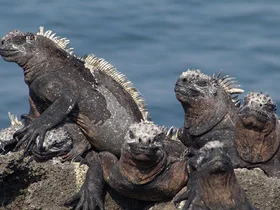The Ocean Spray Cruise Tour
Aboard the Ocean Spray Cruise, you will embark on a memorable journey through the mesmerizing Galapagos Islands.
The 16-passenger luxury catamaran offers spacious suites and social areas with more comfort and stability as you hop from island to island, and exquisite facilities and amenities. Choose from 3, 4 and 7-night cruises.
Between activities and delicious dining experiences, you can appreciate the scenery from your comfortable suite. Each suite provides private balconies for ultimate relaxation and island appreciation. They feature premium eco-friendly amenities, deluxe bedding, and an abundance of natural light.
You will enjoy delicious dining experiences for breakfast, lunch, and dinner al fresco in the open-air lounge or in the comfortable and cozy indoor dining room.
And according to your itinerary, you will head out with skilled naturalist guides to see the iconic wildlife, beautiful scenery and can listen in on fascinating talks about the enchanting islands. Each excursion is guided by top-ranked naturalist guides, ensuring remarkable encounters with the unique Galapagos flora and fauna.
Prepare for unforgettable moments with guided Galapagos walks, kayaking tours, snorkeling and paddleboarding experiences, Zodiac rides and welcome surprises.
The Ocean Spray Cruise Tour Summary
Embark on an extraordinary journey aboard the Ocean Spray Cruise. You will visit secluded islands to find fascinating wildlife and incredible scenery.
Our Galapagos expedition packages aboard the Ocean Spray cater to both short and extended voyages, ensuring an unforgettable experience. Regardless of duration, our expert guides will lead you on captivating daily excursions. See the next tab for an example itinerary. Choose from 3, 4, and 7-night cruises.
Video Introduction
Tour Info
- Focus Area: Galapagos National Park
- Duration: 4, 5, 6 & 8 days
- Start Point: Baltra Airport (GPS)
- End Point: Baltra Airport (GPS)
The Ocean Spray Cruise Itinerary
Rates & Inclusions
4 days / 3 nights
Stateroom (Double Occupancy): $4,190
5 days / 4 nights
Stateroom (Double Occupancy): $5,190
6 days / 5 nights
Stateroom (Double Occupancy): $6,190
8 days / 7 nights
Stateroom (Double Occupancy): $8,290
Notes
- Rates are subject to change in case of additional taxes, fuel price increases or any other unforeseen circumstances.
- Programs per person based on double occupancy
- Suites have king size beds or two twin size beds.
- New surcharges will be published in a timely manner.
- High occupancy dates: A 10% surcharge applies
- High occupancy dates: 100% Single Supplement applies
- Single Suite: Single supplement for suites is 50%
- Single Suite: 100% supplement applies for a second single stateroom, based on the cruise departure occupancy.
- Single Suite: Not applicable during high occupancy dates and subject to availability.
- Children policy: 25% discount per child (#1) applies out of the gross rates when traveling with two adults.
- Children policy: Children must be under 12 years old when they board the cruise.
- Children policy: Not applicable on Christmas and New Years' Eve departures.
- Supplied Expedition Gear Sea kayaks, Ocean paddle boards, Wetsuits and fins, Water containers, Masks and snorkels, Expedition Binoculars, Action Cameras, Micro SD Card 4K (Surcharge)
Included
- Transfers in the Galapagos: airport/catamaran/airport
- Airport reception and assistance
- Double or single accommodations
- Guided expeditions based on itineraries
- Top bilingual National Park guide (English / Spanish)
- Cruise Service Officer
- Daily briefing of activities
- All meals and snacks
- Soft drinks and juices
- Captain’s welcome and farewell cocktails
- Supplied expedition gear
- Use of yoga mats
Not Included
- Round trip to Galapagos
- Galapagos National Park Entrance fee ($100 – subject to change)
- Transit Control Card ($20 – subject to change)
- Alcoholic and bottled beverages
- Gratuities for guide and crew
- Travel and health insurance
Operated By Golden Experiences
About Golden Experiences
Golden Experiences & Travel own and operate unique premium experiences in Ecuador, including La Selva Lodge & Spa and the luxury-class Ocean Spray, Endemic, Elite and Petrel cruises for the Galapagos Islands. These modern and luxurious catamarans are spacious, comfortable, steady, and eminently seaworthy, setting a new standard for luxury yachts in the Galapagos
Golden Experiences promotes a sustainable relationship with the natural and social environment. They offer high-quality service, trained motivated staff, responsible management practices, and maintain positive relationships with the communities they work with.





























































